Honeywell T7200E, T7300D, T7300E User Manual
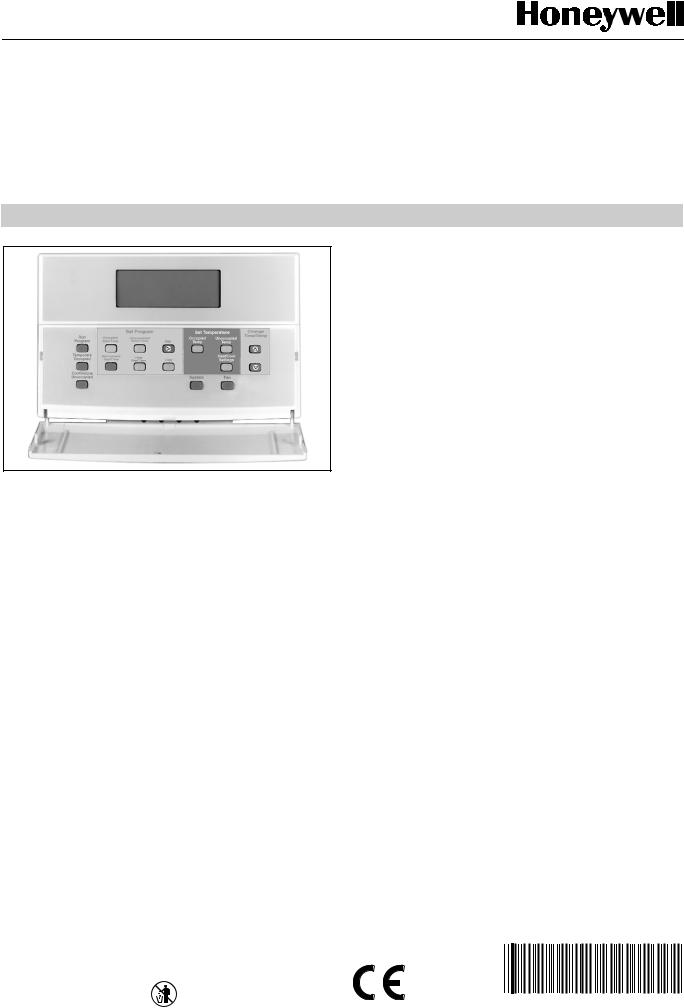
T7200D,E, T7300D,E,F and Q7300
Series 2000 Programmable Commercial
Thermostats and Subbases
PRODUCT DATA
APPLICATION
The T7200, T7300 Thermostats and Q7300 Subbases control 24 Vac commercial single zone heating, ventilating and air conditioning (HVAC) equipment. In addition, the Q7300H Communicating Subbase can communicate schedule information and system instructions to other devices in a LONWORKS® network.
FEATURES
All Models:
•7-day programming.
•Two Occupied and two Unoccupied periods per day.
•Individual heat and cool setpoints available for Occupied and Unoccupied periods.
•Proportional plus Integral (P+I) control eliminates temperature fluctuations.
•Intelligent Recovery® control automatically optimizes equipment start times based on building load.
•Intelligent Fan™ feature energizes fan continuously in the Occupied periods. Fan can also be configured for conventional heat or electric heat fan operation.
•Automatic or manual changeover models available.
•Universal Versaguard™ Thermostat guards available.
•Convenient overrides allow temporary setpoint changes.
•Keypad lockout available.
T7200D,E Thermostats:
•Use on single-stage conventional (T7200D) or heat pump (T7200E) applications.
T7300D,E Thermostats:
•Use on multistage conventional (T7300D) or heat pump (T7300E) applications.
•Models available with remote sensor capability.
T7300F Thermostats:
•Use on single-stage or multistage system in conventional or heat pump applications.
•Auxiliary contacts on Q7300 can be used to interface with C7400/W7459 Economizer System for total integration of rooftop control.
•Remote temperature sensors available for use with all models.
•Different levels of keypad lockout available.
Q7300 Subbase:
•Use with T7300D,E,F Thermostats.
•Auxiliary contacts can be used to interface with C7400/W7459 Economizer System for total integration of rooftop control.
•When used with the T7300F (revision 4 or later), the Q7300H communicates with other network devices.
•Q7300L two stages of heat control ML7984 and V5011/ V5013 valve: stage 1 opens valve 40%; stage 2 100%.
•Q7300L provides two-speed fan control:
—Low: heat and occupied fan.
—High: cooling.
|
Contents |
Application ........................................................................ |
1 |
Features ........................................................................... |
1 |
Specifications ................................................................... |
2 |
Ordering Information ........................................................ |
2 |
Installation ........................................................................ |
5 |
Wiring Subbase/Wallplate ................................................ |
7 |
Settings ............................................................................ |
9 |
Installer Setup .................................................................. |
10 |
Installer System Test ........................................................ |
13 |
Programming .................................................................... |
16 |
Operation .......................................................................... |
19 |
General Operation Information ......................................... |
21 |
Troubleshooting Guide ..................................................... |
22 |
Cross Reference .............................................................. |
23 |
Wiring Diagrams (Fig. 20-34) ........................................... |
29 |
® U.S. Registered Trademark
Copyright © 2001 Honeywell • |
• All Rights Reserved |
63-4355-4 |

T7200D,E, T7300D,E,F AND Q7300 SERIES 2000 PROGRAMMABLE COMMERCIAL THERMOSTATS AND SUBBASES
SPECIFICATIONS
IMPORTANT |
|
|
|
T7200/T7300 Thermostats: See Table 1. |
|
||
The specifications given in this publication do |
|
Q7300 Subbases: See Table 2. |
|
||||
not include normal manufacturing tolerances. |
|
|
|||||
Therefore, this unit might not exactly match the listed |
Dimensions: See Fig. 1. |
|
|
||||
specifications. This product is tested and calibrated |
|
|
|||||
under closely controlled conditions, and some minor |
Finish (color): Taupe. |
|
|
||||
differences in performance can be expected if those |
|
|
|||||
conditions are changed. |
|
|
|
|
|
|
|
|
|
Table 1. T7200 and T7300 Thermostat Features. |
|
|
|||
|
|
|
|
|
|
|
|
|
|
Subbase |
|
Maximum Stages |
|
|
|
|
|
|
|
|
|
Changeoverb |
|
Model |
Applications |
Required |
|
Heat |
Cool |
Wiring Diagram |
|
T7200D |
Conventional |
Nonea |
1 |
|
1 |
20 |
Automatic or |
|
|
|
|
|
|
|
Manual |
T7200E |
Heat Pump |
Nonea |
1 |
|
1 |
21 |
|
|
|
||||||
T7300D |
Conventional |
Q7300A,G,L |
3 |
|
3 |
22-23, 28, 34 |
|
|
|
|
|
|
|
|
|
T7300E |
Heat Pump |
Q7300C,D |
3 |
|
2 |
24-27 |
|
|
|
|
|
|
|
|
|
T7300F |
Conventional or |
Q7300A,C,D,G,L |
3 |
|
3 |
22-28,34 |
|
|
Heat Pump |
|
|
|
|
|
|
|
Q7300H |
3 |
|
3 |
29-33 |
|
|
|
|
|
|
||||
|
|
|
|
|
|
|
|
aWallplate provided.
bConfigured in Installer Setup.
Table 2. Q7300 Subbase Features.
|
|
|
|
|
|
|
|
|
Thermostat |
|
Maximum Stagesa,b |
|
|
Model |
Applications |
Required |
|
Heat |
Cool |
Wiring Diagram |
|
|
|
|
|
|
|
Q7300A |
Conventional |
T7300D,F |
2 |
|
2 |
22-23 |
|
|
|
|
|
|
|
Q7300C |
Heat Pump |
T7300E,F |
3 |
|
2 |
24-26 |
|
|
|
|
|
|
|
Q7300D |
Heat Pump |
T7300E,F |
3 |
|
2 |
27 |
|
|
|
|
|
|
|
Q7300G |
Conventional |
T7300D,F |
3 |
|
3 |
28 |
|
|
|
|
|
|
|
Q7300Hc |
Heat Pump |
T7300F |
3 |
|
2 |
29 |
Q7300Hd |
Heat Pump |
T7300F |
3 |
|
2 |
30 |
Q7300H |
Conventional |
T7300F |
3 |
|
3 |
31 |
|
|
|
|
|
|
|
Q7300H |
Conventional |
T7300F |
2 |
|
1 |
32 |
|
|
|
|
|
|
|
Q7300L |
Conventionale |
T7300D,F |
2 |
|
1 |
34 |
aDepends on model (some specific models have fewer).
bAll subbases are down selectable and can be configured to control fewer stages than the maximum allowed.
cWithout O/B terminals.
dWith O/B terminals.
eUsed with ML7984 Actuator and V5011 or V5013 Valve.
ORDERING INFORMATION
When purchasing replacement and modernization products from your TRADELINE® wholesaler or distributor, refer to the TRADELINE® Catalog or price sheets for complete ordering number.
If you have additional questions, need further information, or would like to comment on our products or services, please write or phone:
1.Your local Home and Building Control Sales Office (check white pages of your phone directory).
2.Home and Building Control Customer Relations Honeywell, 1885 Douglas Drive North
Minneapolis, Minnesota 55422-4386 (800) 328-5111
In Canada—Honeywell Limited/Honeywell Limitée, 35 Dynamic Drive, Scarborough, Ontario M1V 4Z9.
International Sales and Service Offices in all principal cities of the world. Manufacturing in Australia, Canada, Finland, France, Germany, Japan, Mexico, Netherlands, Spain, Taiwan, United Kingdom, U.S.A.
63-4355—4 |
2 |

T7200D,E, T7300D,E,F AND Q7300 SERIES 2000 PROGRAMMABLE COMMERCIAL THERMOSTATS AND SUBBASES
Electrical Ratings:
24 Vac, 50/60 Hz.
20 to 30 Vac, 50/60 Hz.
Batteries: No batteries required.
Auxiliary Heat and Emergency Heat Indication:
Thermostat display indicates when Auxiliary Heat or Emergency Heat are activated.
Loss of Power: The thermostat maintains programmed times and temperatures for the life of the product. The clock and day information is retained for a minimum of two hours.
Light Emitting Diodes (LED):
Two user-defined LED (not available on Q7300H).
Two defined (CHECK and MAINTENANCE) LED on select models.
System Current Draw: 6 VA maximum at 30 Vac, 50/60 Hz.
Output Relay Current Draw: See Table 3.
Table 3. Maximum Amps at 30 Vac.
|
|
|
Relay |
Running (A) |
Inrush (A) |
|
|
|
Fan |
0.5 |
2.5 |
|
|
|
Heat (all stages) |
1.5 |
3.5 |
|
|
|
Cool (all stages) |
1.5 |
7.5 |
|
|
|
Auxiliary (Economizer) |
1.5 |
3.5 |
|
|
|
Temperature:
Ratings:
Operating Ambient: 40°F to 110°F (4°C to 43°C). Shipping: -30°F to +150°F (-34°C to +65°C).
Display Accuracy: ±1°F (±0.5°C).
Setpoint:
Range: 45°F to 95°F (7°C to 35°C).
Deadband: 2°F (1°C).
Default Settings: See Table 4.
Table 4. Default Setpoints.
|
|
|
Control |
Occupied |
Unoccupied |
|
|
|
Heating |
70°F (21°C) |
55°F (13°C) |
|
|
|
Cooling |
78°F (26°C) |
90°F (32°C) |
|
|
|
Remote Sensor Wiring Temperature Offset:
Temperature offset occurs with 500 ft (157m) to 1000 ft (305m) of 2-wire cable. See Table 5.
Humidity Ratings: 5% to 90% RH, noncondensing.
Clock Accuracy: ±1 minute per month.
Table 5. Temperature Offset.
|
|
|
|
Temperature Range |
18 AWG |
20 AWG |
22 AWG |
|
|
|
|
50 to 90°F |
-0.4°F |
-0.7°F |
-1.0°F |
|
|
|
|
10 to 32°C |
-0.3°C |
-0.4°C |
-0.6°C |
|
|
|
|
Minimum Stage Operation Time:
Minimum On (Heat and Cool): factory setting 2 minutes; option 0 minutes.
Minimum Off (Cool and Heat Pump): factory setting 4 minutes; option 0, 1, 3, 5 minutes.
Mounting Means:
T7200: Mounts on a wallplate.
T7300: Mounts on a Q7300 Subbase.
NOTE: Wallplate and subbase mount horizontally on a wall or outlet box with two no. 6 x 32 screws (included).
Accessories:
C7150B1004 Discharge Air Sensor: for checkout use only (form 63-2072).
M7415 Damper Actuator (form 63-2100).
ML7984 Valve Actuator (form 95C-10753). Q7760A Serial LonTalk® Adapter.
R8222 Switching Relay (form 60-2056). T675A Temperature Control (form 60-2200).
T7022A1010 Remote Temperature Sensor (form 60-0247). T7047C Remote Temperature Sensor (form 62-3050). T7047G Remote Temperature Sensor (form 62-3050). T7147A Remote Temperature Sensor and Override Module
(form 62-3049).
W859F Packaged Economizer (form 63-2476). W950A System Supervisor (form 60-2351). W7459 Economizer Logic Module (form 63-2141). W6210/W7210 Economizer (form 63-2528). W6215/W7215 Economizer (form 63-2544).
Approvals:
European Community Mark (CE) Listed.
Q7300H only: LONMARK® Functional Profile No. 8060, Thermostat Object (type 09).
 MERCURY NOTICE
MERCURY NOTICE
If this control is replacing a control that contains mercury in a sealed tube, do not place your old control in the trash. Dispose of properly.
Contact your local waste management authority for instructions regarding recycling and the proper disposal of an old control. If you have questions, call Honeywell Customer Response Center at 1-800-468-1502.
3 |
63-4355—4 |
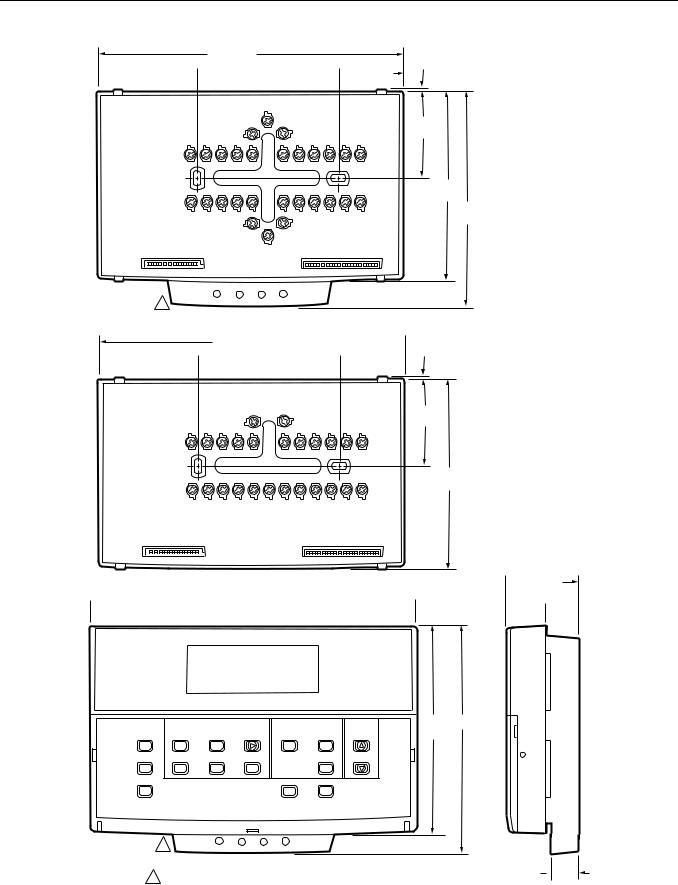
T7200D,E, T7300D,E,F AND Q7300 SERIES 2000 PROGRAMMABLE COMMERCIAL THERMOSTATS AND SUBBASES
6-3/4 (172)
1/16 (2)
 3-1/4 (82)
3-1/4 (82) 
 1-3/8 (35)
1-3/8 (35)
1-7/8
(47)
4-1/8
(105)
4-3/4
(121)
1
Q7300A,C,D,G,L
6-11/16 (170) 
1/16 (2)
 3-3/16 (77)
3-3/16 (77) 
 1-3/8 (35)
1-3/8 (35) 
1-7/8
(47)
4-1/8
(105)
Q7300H
 7-5/16 (186)
7-5/16 (186) 
 1-11/16 (43)
1-11/16 (43)
 7/8
7/8  (22)
(22)
|
|
Set Program |
|
Set Temperature |
Change |
||
Run |
Occupied |
Unoccupied |
|
Occupied |
Unoccupied |
||
Program |
Day |
Time/Temp |
|||||
Start Time |
Start Time |
Temp |
Temp |
||||
Temporary |
Set Current |
Clear |
Copy |
|
Heat/Cool |
|
|
Occupied |
Day/Time |
Start Time |
|
Settings |
|
||
Continous |
|
|
|
System |
Fan |
|
|
Unoccupied |
|
|
|
|
|||
1
T7200D,E; T7300D,E,F
M16292
1 T7200 WALLPLATE DOES NOT HAVE THE LED EXTENSION
4-5/8 5 (127)
(117)
 9/16 (14)
9/16 (14)
Fig. 1. Dimensions of T7200, T7300 and Q7300 in in. (mm).
63-4355—4 |
4 |

T7200D,E, T7300D,E,F AND Q7300 SERIES 2000 PROGRAMMABLE COMMERCIAL THERMOSTATS AND SUBBASES
INSTALLATION
When Installing this Product…
1.Read these instructions carefully. Failure to follow the instructions can damage the product or cause a hazardous condition.
2.Check the ratings given in the instructions and on the product to make sure the product is suitable for your application.
3.Installer must be a trained, experienced service technician.
4.After completing installation, use these instructions to check out the product operation.
Location
Do not install the thermostat where it can be affected by:
—drafts, or dead spots behind doors and in corners.
—hot or cold air from ducts.
—radiant heat from sun or appliances.
—concealed pipes and chimneys.
—unheated (uncooled) areas such as an outside wall behind the thermostat.
T7200 Wallplate or Q7300 Subbase without Remote-Mounted Temperature Sensor
Install the thermostat about 5 ft (1.5m) above the floor in an area with good air circulation at average temperature. See Fig. 2.
Q7300 Subbase with Remote-Mounted Temperature Sensor(s)
If only the remote-mounted temperature sensor(s) is used to sense and control room temperature, then install the thermostat in an area that is accessible for setting and adjusting the temperature and settings.
If both the subbase and remote-mounted temperature sensor(s) are used to sense and control room temperature, then install the subbase about 5 ft above the floor in an area with good air circulation.
Install the remote-mounted sensor(s) about 5 ft (1.5m) above the floor in an area with good air circulation at average temperature. See Fig. 2.
If multiple remote sensors are required, they must be arranged in a temperature averaging network consisting of two, three, four, five or nine sensors. See Fig. 3 through 8.
NOTES:
—When sensor averaging, the T7147A can be substituted for the T7047C. The T7147A includes OVERRIDE and WARMER/COOLER keys.
—Up to four T7147As can be used in parallel to place the thermostat in Temporary Occupied.
|
YES |
|
|
NO |
|
NO |
NO |
|
5 FEET |
||
|
||
|
(1.5 METERS) |
M4823A
Fig. 2. Typical location of thermostat or remote-mounted sensor.
IMPORTANT
To avoid electrical interference, which can cause erratic performances, keep wiring runs as short as possible and do not run thermostat wires adjacent to the line voltage electrical distribution systems. Use shielded cable (Belden type 8762 or equivalent for 2-wire and Belden type 8772 or equivalent for 3-wire). The cable shield must be grounded only at the controlled equipment case.
SUBBASE
T T
T7047C
T T
M4839BB
Fig. 3. One T7047C Sensor providing temperature sensing for T7300/Q7300 Thermostat/Subbase.
|
SUBBASE |
T |
T |
T7047G |
T7047G |
T |
T |
T |
T |
M4838
Fig. 4. Two T7047G Sensors providing temperature averaging network for T7300/Q7300 Thermostat/Subbase.
5 |
63-4355—4 |
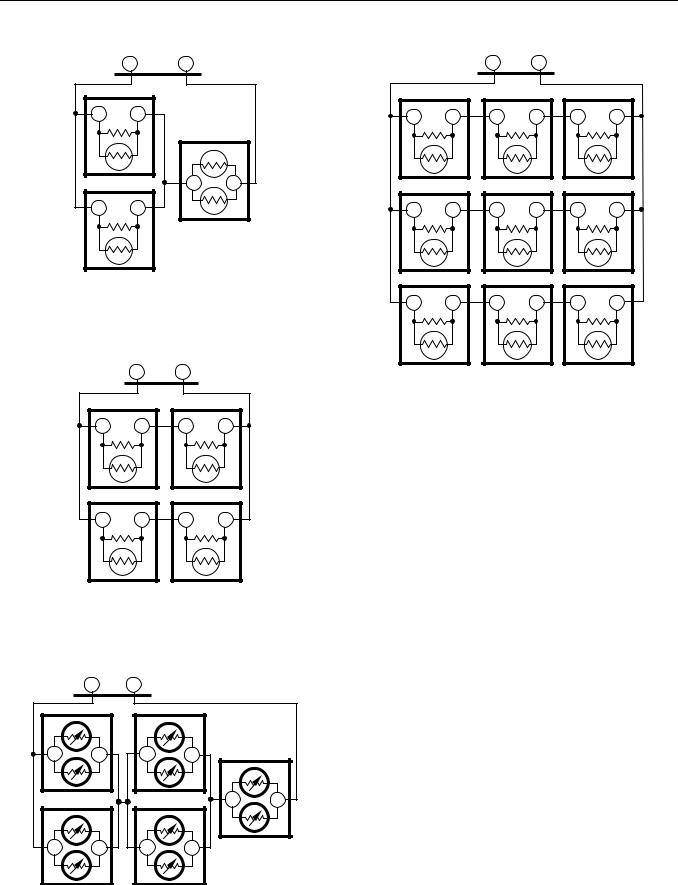
T7200D,E, T7300D,E,F AND Q7300 SERIES 2000 PROGRAMMABLE COMMERCIAL THERMOSTATS AND SUBBASES
SUBBASE
T |
T |
|
T7047C |
|
|
T |
T |
|
|
T7047G |
|
T7047C |
T |
T |
T |
T |
|
M4839
Fig. 5. Two T7047C Sensors and one T7047G Sensor providing temperature averaging network for T7300/Q7300 Thermostat/Subbase.
SUBBASE
|
T |
T |
|
T7047C |
|
T7047C |
|
T |
T |
T |
T |
T7047C |
|
T7047C |
|
T |
T |
T |
T |
M4840
Fig. 6. Four T7047C Sensors providing temperature averaging network for T7300/Q7300 Thermostat/Subbase.
|
SUBBASE |
|
|
|
|
T |
|
T |
|
|
|
T7047G |
|
T7047G |
|
|
|
T |
T |
T |
T |
T7047G |
|
T7047G |
|
T7047G |
|
T |
T |
|
|
|
|
||
T |
T |
T |
T |
|
|
|
|
|
|
|
M4841 |
Fig. 7. Five T7047G Sensors providing temperature averaging network for T7300/Q7300 Thermostat/Subbase.
|
|
SUBBASE |
|
|
|
|
|
T |
T |
|
|
T7047C |
|
T7047C |
|
T7047C |
|
T |
T |
T |
T |
T |
T |
T7047C |
|
T7047C |
|
T7047C |
|
T |
T |
T |
T |
T |
T |
T7047C |
|
T7047C |
|
T7047C |
|
T |
T |
T |
T |
T |
T |
M4842
Fig. 8. Nine T7047C Sensors providing temperature averaging network for T7300/Q7300 Thermostat/Subbase.
NOTE: With the thermostat configured for a temperature averaging network (remote and internal sensing), the internal sensor has 50% authority of the averaged temperature.
Mounting Subbase/Wallplate
The subbase/wallplate mounts horizontally on the wall or a 2 in. by 4 in. wiring box. Position the subbase/wallplate horizontally on the wall or on a 2 in. by 4 in. wiring box.
1.Position and level the subbase/wallplate.
NOTE: A level wallplate is only for appearance. The thermostat functions properly when not level.
2.Use a pencil to mark the mounting holes. See Fig. 9.
3.Remove the subbase/wallplate from the wall and drill two 3/16 inch holes in the wall (if drywall) as marked. For firmer material such as plaster or wood, drill two 7/32 inch holes. Gently tap anchors (provided) into the drilled holes until flush with the wall.
4.Position the subbase/wallplate over the holes, pulling wires through the wiring opening.
5.Loosely insert the mounting screws into the holes.
6.Tighten mounting screws.
63-4355—4 |
6 |
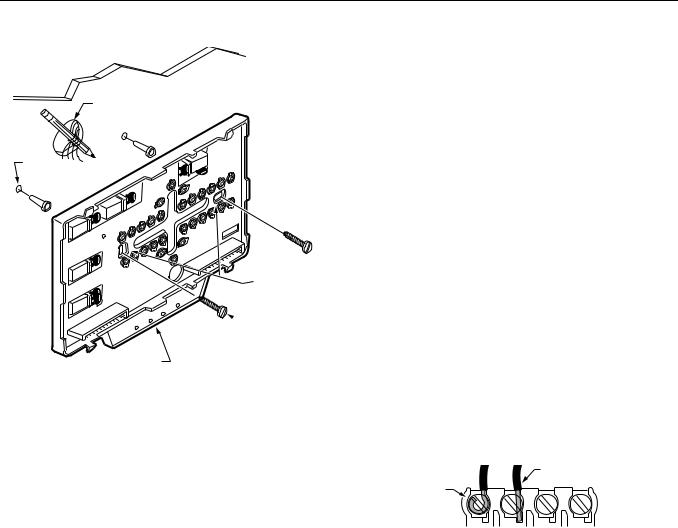
T7200D,E, T7300D,E,F AND Q7300 SERIES 2000 PROGRAMMABLE COMMERCIAL THERMOSTATS AND SUBBASES
WALL
WIRES
THROUGH WALL
WIRING SUBBASE/WALLPLATE
IMPORTANT
All wiring must comply with local electrical codes and ordinances.
WALL ANCHORS
(2)
MOUNTING
HOLES
 MOUNTING
MOUNTING
SCREWS
M10237
LEDS
Fig. 9. Mounting subbase or wallplate.
Follow equipment manufacturer wiring instructions when available. Refer to the Wiring section for typical hookups. A letter code is located near each terminal for identification. Refer to Table 6 for terminal designations.
 CAUTION
CAUTION
Electrical Shock Hazard.
Power supply can cause electrical shock.
Disconnect power before beginning installation.
1.Loosen the terminal screws on the subbase/wallplate and connect the system wires. See Fig. 10.
IMPORTANT
Use 18-gauge, solid-conductor color-coded thermostat cable for proper wiring. If using 18gauge stranded wire, no more than ten wires can be used. Do not use larger than 18-gauge wire.
2.Securely tighten each terminal screw.
3.Push excess wire back into the hole.
4.Plug the hole with nonflammable insulation to prevent drafts from affecting the thermostat.
|
|
FOR WRAPAROUND |
FOR STRAIGHT INSERTION |
|
|
|
INSERTION STRIP |
STRIP 5/16 IN. (8 MM). |
|
|
|
7/16 IN. (11 MM). |
|
|
|
|
|
|
M4826 |
|
|
Fig. 10. Proper wiring technique. |
||
|
|
Table 6. Terminal Designations and Descriptions. |
|
|
|
|
|
|
|
Terminal Designations |
|
|
Terminal |
|
|
|
|
|
|
Standard |
Alternate |
Typical Connection |
Function |
Type |
|
|
|
|
|
A1 |
A2a |
Dry auxiliary contacts for economizer control; A1 is normally open |
Output |
Dry contact |
|
|
during Unoccupied periods and closed during Occupied periods. |
|
|
|
|
|
|
|
A1, A2 |
— |
Damper control relay (Q7300L only). |
Input, Output |
24V powered |
|
|
|
|
contact |
|
|
|
|
|
A2 |
A1a |
Dry auxiliary contacts for economizer control (A2 is common). |
Input |
Dry contact |
A3 |
— |
Dry auxiliary contacts for economizer control; A3 is normally open |
Output |
Dry contact |
|
|
during Occupied periods and closed during Unoccupied periods. |
|
|
|
|
|
|
|
AS, AS |
— |
C7150B Discharge Air Sensor connection. |
Input |
— |
|
|
|
|
|
B |
— |
Heating changeover valve. |
Output |
24V powered |
|
|
|
|
contact |
|
|
|
|
|
C1, C2, C3, |
— |
Communication input for T7147. |
Input |
Low power |
C4, C5 |
|
|
|
|
|
|
|
|
|
E |
K |
Emergency heat relay. |
Output |
24V powered |
|
|
|
|
contact |
|
|
|
|
|
aSome OEM models reverse the economizer terminal designations A1 and A2.
bSome OEM models label the terminal for transformer common B.
cApplies only to Q7300H2037.
7 |
63-4355—4 |

T7200D,E, T7300D,E,F AND Q7300 SERIES 2000 PROGRAMMABLE COMMERCIAL THERMOSTATS AND SUBBASES
Table 6. Terminal Designations and Descriptions. (Continued)
|
|
|
|
|
Terminal Designations |
|
|
Terminal |
|
|
|
|
|
|
Standard |
Alternate |
Typical Connection |
Function |
Type |
|
|
|
|
|
EB, EB |
— |
Q7300H LONWORKS® bus connection to LONWORKS® network. |
Input, Output |
Communi- |
|
|
|
|
cations |
|
|
|
|
|
G |
F |
Fan relay. |
Output |
24V powered |
|
|
|
|
contact |
|
|
|
|
|
O |
R |
Cooling changeover valve. |
Output |
24V powered |
|
|
|
|
contact |
|
|
|
|
|
R |
V |
24V system transformer. |
Input |
— |
|
|
|
|
|
RC |
— |
24V cooling transformer. |
Input |
— |
|
|
|
|
|
RH |
— |
24V heating transformer. |
Input |
— |
|
|
|
|
|
T, T |
— |
Remote sensor input for T7047 or T7147. |
Input |
— |
|
|
|
|
|
W1 |
H1, R3 |
Stage 1 heating relay (Q7300A,G,H) or auxiliary heat relay |
Output |
24V powered |
|
|
(Q7300C,D,H). |
|
contact |
|
|
|
|
|
W2 |
H2, R4, W3, Y |
Stage 2 heating relay. |
Output |
24V powered |
|
|
|
|
contact |
|
|
|
|
|
W3 |
— |
Stage 3 heating relay. |
Output |
24V powered |
|
|
|
|
contact |
|
|
|
|
|
X |
Bb, C, X1, X2 |
Common. |
Input |
|
X1, X3 |
A, A1, A2, C, |
User defined Light Emitting Diodes (LED). |
Annunciation |
— |
|
L, X, Z |
|
|
|
|
|
|
|
|
X4 |
— |
LED common. |
Annunciation |
— |
|
|
|
|
|
Y1 |
C1, M, Y |
Stage 1 compressor contactor (Q7300C,D,H). |
Output |
24V powered |
|
|
|
|
contact |
|
|
|
|
|
Y1, Y |
RS, M |
Stage 1 cooling compressor (Q7300A,G,Hc,L). |
Output |
24V powered |
|
|
|
|
contact |
Y2 |
C2 |
Stage 2 cooling compressor (conventional). |
Output |
24V powered |
|
|
Stage 2 compressor contactor (heat pump). |
|
contact |
|
|
|
|
|
Y3 |
— |
Stage 3 cooling compressor. |
Output |
24V powered |
|
|
|
|
contact |
|
|
|
|
|
BM |
— |
ML7984 Actuator connection (Q7300Hc, L only); no call for heat, |
Output |
— |
|
|
valve closed; call for stage 1 heat, valve approximately one-half |
|
|
|
|
open; call for stage 2 heat, valve fully open. |
|
|
|
|
|
|
|
FC |
— |
Fan control transformer (Q7300Hc, L only). |
Input |
— |
GH |
— |
High-speed fan output (Q7300Hc, L only); activate during calls for |
Output |
24V powered |
|
|
cooling. |
|
contact |
|
|
|
|
|
GL |
— |
Low-speed fan output (Q7300Hc, L only); activated on calls for heat |
Output |
24V powered |
|
|
and fan On selection. |
|
contact |
|
|
|
|
|
P1, P2 |
— |
Pump interlock relay (Q7300Hc, L only); operates circulator pump in |
Input, Output |
24V powered |
|
|
hydronic heat or energizes conventional heat system. |
|
contact |
|
|
|
|
|
RM |
— |
ML7984A Actuator connection (Q7300Hc, L only); no call for heat, |
Output |
— |
|
|
valve closed; call for stage 1 heat, valve approximately one-half |
|
|
|
|
open; call for stage 2 heat, valve fully open. |
|
|
|
|
|
|
|
— |
C, H, L |
HSII Control Panel. |
— |
— |
|
|
|
|
|
— |
O |
Momentary circuit changeover. |
— |
— |
|
|
|
|
|
— |
P |
Defrost. |
— |
— |
|
|
|
|
|
— |
R1, R2 |
Lowand high-speed fan relays. |
— |
— |
|
|
|
|
|
— |
T |
External temperature readout, T-relay; outdoor thermistor. |
— |
— |
|
|
|
|
|
aSome OEM models reverse the economizer terminal designations A1 and A2.
bSome OEM models label the terminal for transformer common B.
cApplies only to Q7300H2037.
63-4355—4 |
8 |
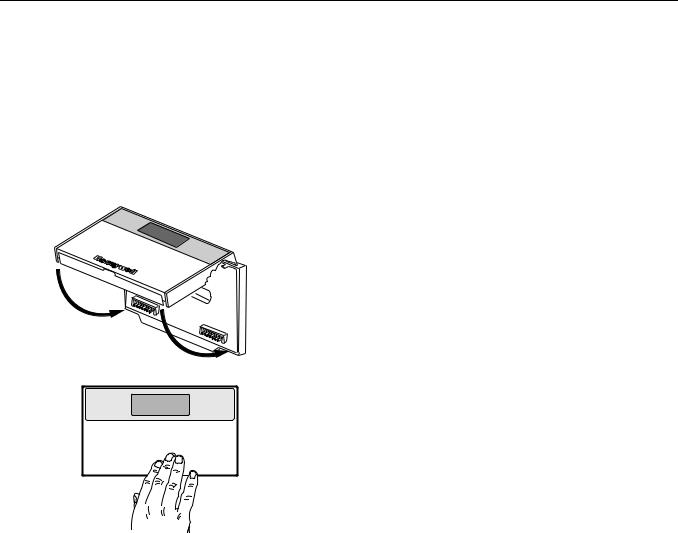
T7200D,E, T7300D,E,F AND Q7300 SERIES 2000 PROGRAMMABLE COMMERCIAL THERMOSTATS AND SUBBASES
Mounting Thermostat on Subbase/Wallplate
The thermostat mounts on the subbase/wallplate after it is installed:
1.Engage the tabs at the top of the thermostat and subbase/wallplate. See Fig. 11.
2.Press the lower edge of the case to latch.
NOTE: To remove the thermostat from the wall, first pull out at the bottom of the thermostat; then remove the top.
A. ENGAGE TABS AT TOP OF THERMOSTAT AND SUBBASE OR WALLPLATE.
B. PRESS LOWER EDGE OF CASE TO LATCH.
M4824A
Fig. 11. Mounting thermostat on subbase/wallplate.
SETTINGS
Using Thermostat Keys
The thermostat keys are used to:
•set current time and day,
•program times and setpoints for heating and cooling,
•override the program temperatures,
•display present setting,
•set system and fan operation,
•configure Installer Setup,
•check Installer System Test.
See Fig. 12 for key information.
Setting System and Fan (select models)
The system default setting is Heat. The fan default is set so the fan operates continuously in Occupied periods, Unoccupied period recovery times and with the heating and cooling equipment in Unoccupied periods. Use the System and Fan keys to change the settings. Fan and system operation are configured in the Installer Setup options.
The system settings are:
—Em Heat (T7200E, T7300/Q7300C,D,H): Emergency heat relay is on continuously. Thermostat cycles highest stage of heat. Cooling system is off. Compressor is de-energized.
—Heat: Thermostat controls the heating.
—Off: Both the heating and cooling are off.
—Cool: Thermostat controls the cooling.
—Auto: Thermostat automatically changes between heating and cooling depending on the indoor temperature.
The fan settings are:
—On: Fan operates continuously in occupied period.
—Auto: Equipment controls the fan in the Unoccupied periods. The Intelligent Fan™ operation (Installer Setup number 17) offers three choices for the fan operation in Occupied periods:
—fan turns on only when there is a call for heat or cool.
—fan operates continuously in Occupied periods.
—fan is on continuously in Occupied periods and Unoccupied period recovery times.
Setting Temperature
Refer to Table 4 for the default temperature setpoints. See Programming section for complete instructions on changing the setpoints.
9 |
63-4355—4 |
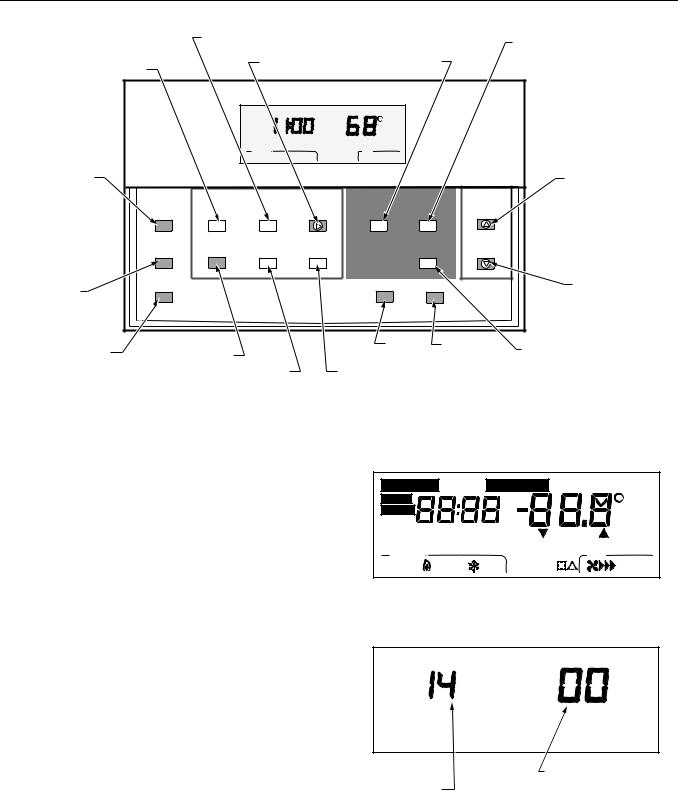
T7200D,E, T7300D,E,F AND Q7300 SERIES 2000 PROGRAMMABLE COMMERCIAL THERMOSTATS AND SUBBASES
|
ENTER UNOCCUPIED |
SET OCCUPIED |
SET UNOCCUPIED TEMPERATURE |
|
PROGRAM MODE |
||
|
TEMPERATURE |
SETPOINTS AND SCROLLS |
|
ENTER OCCUPIED |
|
||
SET CURRENT DAY OR |
SETPOINTS |
THROUGH INSTALLER SETUP |
|
PROGRAM MODE |
PROGRAM DAY |
|
AND SYSTEM TEST |
|
|
|
|
AM |
Room |
|
|
|
|
|
|
|
|
|
|
|
|
|
Mon |
|
|
|
|
|
|
|
Occupied |
|
|
|
|
|
|
|
System |
|
Fan |
|
|
RETURNS TO |
|
|
Heat |
|
Auto |
|
|
NORMAL |
|
|
|
|
|
|
|
OPERATIONS |
|
|
|
|
|
|
|
|
|
|
Set Program |
|
Set Temperature |
Change |
|
|
Run |
Occupied |
Unoccupied |
|
Occupied |
Unoccupied |
Time/Temp |
|
|
|
|||||
|
Program |
Start Time |
Start Time |
Day |
Temp |
Temp |
|
SET OVERRIDE |
Temporary |
Set Current |
Clear |
|
|
Heat/Cool |
|
TEMPERATURE |
Occupied |
Day/Time |
Start Time |
Copy |
|
Settings |
|
OFFSET AND |
|
|
|
|
|
|
|
ACTIVATE |
Continuous |
|
|
|
|
|
|
TEMPORARY |
|
|
|
|
|
|
|
Unoccupied |
|
|
|
System |
Fan |
|
|
OVERRIDE |
|
|
|
|
|||
|
|
|
|
|
|
|
|
ENTER HOLD MODE |
SET CURRENT |
|
|
SELECT |
SELECT FAN |
||
DAY AND TIME |
|
|
SYSTEM |
OPERATION |
|||
|
|
|
|
|
OPERATION |
|
|
|
|
CLEAR PROGRAM PERIOD |
|
COPY ONE |
|
|
|
|
|
|
|
|
PROGRAMMED DAY |
|
|
|
|
|
|
|
TO ANOTHER DAY |
|
|
INCREASE
TEMPERATURE
OR TIME SETTING
DECREASE
TEMPERATURE
OR TIME SETTING
CHANGE BETWEEN HEATING AND COOLING SETPOINTS AND SCROLLS BACKWARDS THROUGH INSTALLER SETUP NUMBERS AND SYSTEM TEST
M10233A
Fig. 12. Thermostat key locations and descriptions.
INSTALLER SETUP
NOTE: For most applications, the thermostat factory settings do not need to be changed. Review the factory settings in Table 7 and if no changes are necessary, go to the Installer System Test section.
The installer uses the Installer Setup to customize the thermostat to specific systems. (See Table 7.) The table includes all the configuration options available.
A combination of key presses are required to use the Installer Setup feature:
—To enter the Installer Setup, press and hold Heat/Cool Settings and both the increase ▲ and decrease ▼ keys until the first number is displayed. All display segments appear for approximately three seconds before the number is displayed. See Fig. 13 and 14.
—To advance to the next Installer Setup number, press
Unoccupied Temp.
—To return to an Installer Setup number, press Heat/Cool Settings.
—To change a setting, use the increase ▲ or decrease ▼ key.
—To exit the Installer Setup, press Run Program.
NOTES:
—Installer Setup is automatically exited after four minutes with no key pressed.
—Be sure to set thermostat time after exiting Installer Setup.
—Installer Setup numbers are listed in Table 7.
Set Program Start Time Set Day/Time Temporary Setting Enrg |
|||||
Em Ht |
|
AM |
|
Sav |
|
Aux Ht |
|
|
Room |
||
|
PM |
|
|||
Comm |
|
|
%Humid |
||
|
|
|
|
||
MonTueWedThuFriSatSun |
Heat Cool |
Remote |
|||
UnOccupied 12 Override |
In Recovery |
Auto Only Duct |
|||
System |
OffCool |
Auto |
LoMedHi |
Fan |
OnAuto |
Em Heat |
Wait |
|
|||
|
|
|
|
|
M4916 |
Fig. 13. LED display of all segments.
MODE NUMBER |
M10227 |
DISPLAY |
FACTORY SETTING |
(COLUMN 2 |
OR OTHER CHOICE |
OF TABLE 8) |
DISPLAY (COLUMN 3 |
|
OR 5 OF TABLE 8) |
Fig. 14. Installer Setup number and setting display.
63-4355—4 |
10 |

T7200D,E, T7300D,E,F AND Q7300 SERIES 2000 PROGRAMMABLE COMMERCIAL THERMOSTATS AND SUBBASES
 CAUTION
CAUTION
Possible Equipment Damage.
Fan must be running when system is operating.
Heat pump and electric heat systems must be configured correctly in Installer Setup 2 to prevent equipment damage caused by the system running without the fan.
IMPORTANT
Only configurable numbers are shown on the device. Example: If the thermostat does not have a system key, Installer Setup number 12 will not be displayed. Review Table 7 factory settings and mark any desired changes in the Actual Setting column. When the Installer Setup is complete, review the settings to confirm that they match the system.
Table 7. Thermostat Installer Setup Options.
|
|
|
|
|
|
|
|
|
|
Installer Setup |
|
|
|
|
|
Other Choices |
|
|
Number |
|
Factory Setting |
|
|
|
(Press ▲ or ▼ to change) |
|
Select |
(Press Unoccupied |
|
|
|
|
|
|
Actual |
|
|
|
|
|
|
|||
Temp to change) |
Display |
Description |
Display |
|
|
Description |
Setting |
|
|
|
|
|
|
|
|
|
|
Not used |
1 |
— |
— |
— |
— |
|
— |
|
|
|
|
|
|
|
|
||
Fan operationa |
2 |
0 |
Conventional applications where |
1 |
Electric heat applications where thermostat |
|
||
|
|
|
equipment controls fan operation |
|
controls fan operation in heat mode. |
|
||
|
|
|
in heat mode. |
|
|
|
|
|
|
|
|
|
|
|
|
|
|
Output stages of |
3 |
Subbase |
Stages of heat. |
0, 1, 2, |
0: |
|
No heating. |
|
heating |
|
dependant |
|
or 3 |
1: One stage of heat. |
|
||
|
|
|
|
|
2: Two stages of heat. |
|
||
|
|
|
|
|
3: Three stages of heat. |
|
||
|
|
|
|
|
|
|
|
|
Heating cycle rate |
4 |
4 |
Stage 1: 4 cph. |
3, 6, 8 or |
3: |
3 cph (hot water systems or high |
|
|
|
|
|
|
9 |
|
|
efficiency furnaces). |
|
|
5 |
4 |
Stage 2: 4 cph. |
|
|
|
||
|
|
6: 6 cph (conventional systems). |
|
|||||
|
|
|
|
|
|
|||
|
6 |
4 |
Stage 3: 4 cph. |
|
|
|||
|
|
8: 8 cph (conventional systems). |
|
|||||
|
7 |
4 |
Emergency heat relay is on |
|
9: |
|
9 cph (electric heat systems). |
|
|
|
|
continuously. Highest stage of |
|
|
|
|
|
|
|
|
heat cycles at 4 cph (Q7300C or D |
|
|
|
|
|
|
|
|
only). |
|
|
|
|
|
|
|
|
|
|
|
|
|
|
Cooling output |
8 |
Subbase |
Stages of cooling. |
0, 1, 2 or |
0: |
|
No cooling. |
|
stages |
|
dependant |
|
3 |
1: |
|
One cooling stage. |
|
|
|
|
|
|
2: |
|
Two cooling stages. |
|
|
|
|
|
|
3: |
|
Three cooling stages. |
|
|
|
|
|
|
|
|
|
|
Cooling cycle rate |
9 |
4 |
Stage 1: 4 cph. |
3 |
3: |
|
3 cph. |
|
|
|
|
|
|
|
|
|
|
|
10 |
4 |
Stage 2: 4 cph. |
|
|
|
|
|
|
|
|
|
|
|
|
|
|
|
11 |
4 |
Stage 3: 4 cph. |
|
|
|
|
|
|
|
|
|
|
|
|
||
System setting |
12 |
Model |
System selection. |
0, 1 or 2 |
0: System setting key is operational. |
|
||
adjustment |
|
dependant |
|
|
1: |
|
Auto setting disabled. |
|
(models with |
|
|
|
|
2: |
|
Auto only setting. |
|
System key) |
|
|
|
|
|
|
|
|
|
|
|
|
|
|
|
|
|
Not used |
13 |
— |
— |
— |
— |
|
— |
|
|
|
|
|
|
|
|
||
Degree |
14 |
0 |
Temperature displayed in °F. |
1 |
Temperature displayed in °C. |
|
||
temperature |
|
|
|
|
|
|
|
|
display |
|
|
|
|
|
|
|
|
|
|
|
|
|
|
|
||
Displaying |
15 |
0 |
Temperature displayed. |
1 |
Temperature not displayed. |
|
||
temperature |
|
|
|
|
|
|
|
|
(T7300F only). |
|
|
|
|
|
|
|
|
|
|
|
|
|
|
|
||
Clock format. |
16 |
0 |
12-hour clock format. |
1 |
24-hour clock format. |
|
||
|
|
|
|
|
|
|
|
|
Intelligent Fan™ |
17 |
2 |
Fan operates continuously in |
0 or 1 |
0: |
Fan operates only with call for heat or |
|
|
operation. |
|
|
Occupied and recovery modes. |
|
|
|
cool (Occupied and Unoccupied modes). |
|
|
|
|
Fan operates with call for heat or |
|
1: |
Fan operates continuously in Occupied |
|
|
|
|
|
cool in Unoccupied mode. |
|
|
|
mode. Fan operates with call for heat or |
|
|
|
|
|
|
|
|
cool in Unoccupied mode. |
|
|
|
|
|
|
|
|
|
|
Auxiliary contact |
18 |
0 |
0: Time of day contact. |
1 |
1: |
|
Economizer contacts. |
— |
operation. |
|
|
|
|
|
|
|
|
|
|
|
|
|
|
|
|
|
aNumber 2 must be set to 1 to extend fan operation.
bNumber 22 must be set to 1 and remote sensor(s) must be installed.
11 |
63-4355—4 |
